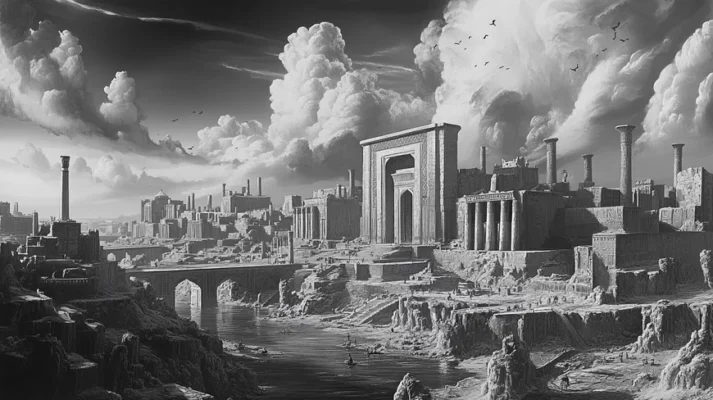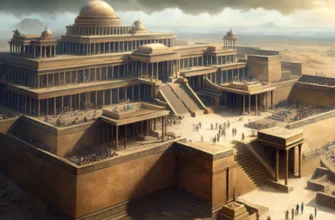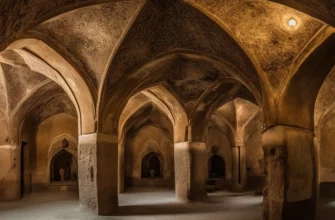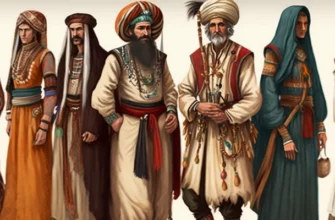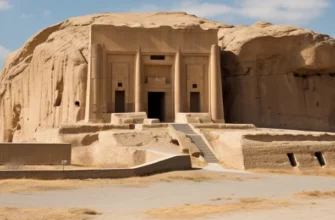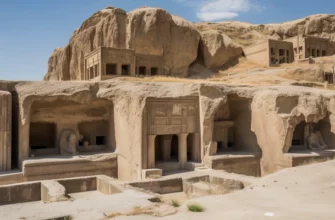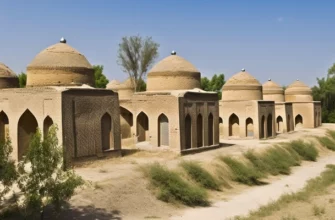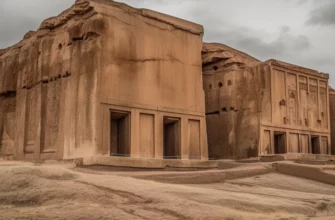Persepolis is an ancient city that was the capital of the vast Achaemenid Empire in Iran. Founded in the mid-6th century BC by King Darius I, it became a symbol of Iran’s prosperity and power. Persepolis was located on a hillside, which gave it a majestic appearance, and was built with grandiose architectural skill.
The city impressed with its architecture: large palaces, temples, monumental staircases, and bas-reliefs depicting majestic scenes from the lives of kings and gods. The pride of Persepolis was its royal palace, where important ceremonies were held, including coronations and receptions of foreign ambassadors.
Persepolis flourished until 330 BC, when the city was destroyed during the campaign of Alexander the Great. He burned the city as an act of revenge for the destruction of Athens by the Persians. Despite this, the ruins of Persepolis have preserved important evidence of the greatness and cultural heritage of Ancient Iran.
Today, Persepolis is an important archaeological site that attracts tourists from all over the world. The city has become a symbol of Iran’s cultural and historical heritage, continuing to impress with its beauty and grandeur even after thousands of years.
- Description of Persepolis as the historical capital of the Achaemenids
- History of Persepolis
- Architectural features of Persepolis
- The Temple of Fire and the Royal Palaces
- Description of the main architectural objects
- Planning and infrastructure
- Features of the city’s location and organization
- Cultural significance of Persepolis
- Persepolis in myths and literature
- Persepolis in contemporary culture
- Archaeological excavations and research
- Conclusion
Description of Persepolis as the historical capital of the Achaemenids
Persepolis was the historical capital of the Achaemenids, a dynasty that ruled Iran from the 6th to the 4th century BC. Founded by King Darius I in 518 BC, Persepolis became a symbol of the greatness and power of the Achaemenids.
The city was not only the political center of the empire, but also an important cultural and religious center.
Located on the slopes of Mount Ram, Persepolis impressed with its architectural beauty and size. It was a huge complex that included palaces, temples, barracks, as well as huge staircases and bas-reliefs depicting important historical events and episodes from the lives of kings.
The royal palace, where important ceremonies such as coronations and receptions of foreign ambassadors were held, was one of the main symbols of power and wealth. Persepolis was also the place where the archives of the empire were kept, including the famous cuneiform tablets that testified to the administrative and economic affairs of the Achaemenids.
The city was a major commercial and cultural center, where roads from different parts of the empire converged. Thus, Persepolis was not only the capital, but also an important link in maintaining and strengthening the power of the Achaemenids over the vast territory of Iran and its surroundings.
Persepolis became a symbol not only of political power but also of the high culture that developed under the Achaemenids. Although the city was destroyed during the invasion of Alexander the Great in 330 BC, its grandeur lives on in the ruins and monuments that have survived to this day.
History of Persepolis
Persepolis, the capital of the Achaemenid Empire, has a rich and magnificent history spanning several centuries. It was founded during the reign of Darius I, who began construction of the city in 518 BC on the site of an ancient settlement.
The city became a symbol of the power and cultural greatness of the Achaemenid Empire, one of the largest and most influential empires in the ancient world.
Foundation and heyday (518 BC – 330 BC)
Darius I chose the site for Persepolis on the slopes of Mount Ram so that it could serve as a magnificent capital. Construction took several decades and included palaces, temples, assembly halls, and monumental stairways that impressed with their architectural perfection. Persepolis was not only a political center, but also an important religious and cultural center. The city became the venue for important ceremonies, such as the coronation of kings and the reception of foreign ambassadors.
During the reign of Darius I and his successors, strong centralized power allowed Persepolis to develop as one of the largest administrative and commercial centers of the Achaemenid Empire.
The city also became the repository for the empire’s documents — the famous cuneiform tablets, which were important for administrative management and trade.
Decline and destruction (330 BC)
Persepolis fell into decline in 330 BC when Alexander the Great, during his conquest of Persia, captured the city.
Alexander, outraged by the Persians’ burning of Athens in 480 BC, decided to take revenge on Persepolis by burning the city. This destruction was a symbolic act of punishment for the Achaemenids. After that, Persepolis was abandoned, and most of its huge buildings and palaces were destroyed.
Current state
Today, the ruins of Persepolis are one of the most important archaeological sites in Iran and the world. They provide unique evidence of the rise and fall of the Achaemenids and the high skill of the architects and artists of that time. Persepolis continues to attract archaeologists and tourists interested in the cultural heritage of Ancient Iran.
Architectural features of Persepolis
Persepolis is a striking example of the architectural grandeur and engineering skill achieved during the Achaemenid Empire. The city’s architecture combines elements of Persian, Mesopotamian, and Egyptian traditions, creating a unique style that reflects the wealth and culture of Ancient Iran. The city was built with great attention to detail, reflecting the grandeur of the empire and its rulers.
- Palaces and royal buildings
Persepolis was designed to emphasize the grandeur and status of the Achaemenid royal family. The main architectural landmark of the city was the palace of Darius I, one of the largest and most impressive structures.
The palaces were built on large platforms that raised them above ground level, creating an impression of grandeur and importance. The central palace of Darius I had large halls for ceremonial receptions and celebrations, where important ceremonies were held, as well as royal apartments.
- Grand staircases and entrances
Persepolis was famous for its grand staircases. The most famous staircase leads to the main palace and is impressive due to its proportions and design.
The entrance to the city also had huge gates that emphasized the grandeur of the rulers. One of the most notable architectural features is the Gate of All Nations, built to receive ambassadors from different parts of the vast Achaemenid Empire.
- Bas-reliefs and sculptures
Persepolis is famous for its intricate and detailed bas-reliefs and sculptural compositions that adorn the walls of palaces and temples. These images often depict scenes from the lives of kings and their subjects, as well as important religious and cultural rituals.
One of the most famous is a bas-relief depicting King Darius I receiving gifts from representatives of various peoples of the empire, emphasizing the multinational character of the Achaemenids.
- Infrastructure and city planning
Persepolis was planned with great consideration for the terrain and geographical conditions. The city was built on a large platform, which ensured stability and security. The streets of Persepolis were straight and spacious, which ensured efficient traffic flow. The city had specially designated areas for ritual ceremonies, as well as for large celebrations and solemn events.
- Temples and religious buildings
Persepolis was also famous for its religious buildings, among which the fire temple stands out. The Persians worshipped fire as a sacred element, and the fire temple was one of the main places of worship. The architecture of these buildings was simple but majestic, using stone and wood, which created a sense of peace and festivity.
- Use of materials
High-quality materials were used to build Persepolis: stone, wood, bronze, and gold. The stone blocks used to build the main structures were distinguished by their size and weight, which allowed the buildings to remain stable for centuries. Bronze and gold were used to make decorative elements that emphasized the wealth of the empire.
- Water supply system
A complex water supply system was developed to ensure the city’s viability. The city had drainage channels and water collection systems, which allowed comfortable conditions to be maintained for the inhabitants and visitors of Persepolis even during the hot season.
The architecture of Persepolis reflects the high level of development of the Achaemenid civilization. Majestic palaces, monumental staircases, religious buildings, and bas-reliefs depicting important moments in history create a unique image of this magnificent city. Persepolis was not only the political and cultural center of its time, but also left behind an indelible impression of architectural and artistic perfection.
The Temple of Fire and the Royal Palaces
The Temple of Fire and the Royal Palaces are among the most important architectural and religious elements of Persepolis, reflecting both the religious beliefs and the grandeur of the Achaemenid royal power.
The Temple of Fire
One of the central religious elements of Persepolis was the Temple of Fire, which emphasized the importance of fire in the Persian religion. Fire was a symbol of purity and divine light in Zoroastrianism, the main religion of the time in Iran. Fire worship in temples was of great importance, and the fire temple in Persepolis was one of the most revered places of worship.
The fire temple in Persepolis was not lavishly decorated, but its simplicity and solemnity emphasized its deep religious significance. The fire burning in such temples symbolized the constant presence of God on earth. These temples were usually open, with huge hearths or special structures where the sacred fire was kept burning.
In Persepolis, the temple of fire was part of the overall architectural composition, indicating the importance of religion in the life of the royal family and the state. An important aspect of the temple was its use for ceremonies and rituals that supported the political legitimacy and religious power of the king.
Royal palaces
The palaces of Persepolis, in particular the palace of Darius I, were the main symbols of the Achaemenid royal power. These magnificent structures not only served administrative functions but were also of great importance for demonstrating the power and luxury of the empire.
The palace of Darius I was built on a large stone platform that raised it above the city, giving the structure a majestic appearance. The main purpose of the palace was to host important state ceremonies, such as coronations, receptions of foreign ambassadors, and diplomatic missions. Huge halls, spacious corridors, and grand staircases were part of the architectural composition that emphasized royal dignity and authority.
One of the most impressive elements of the royal palaces were the large columns that supported the roofs. The columns were made of stone and had intricate carved capitals, often decorated with images of kings or mythological creatures, emphasizing the power of the royal family.
The interior of the palaces was also impressive. Large halls with high ceilings and decorated walls featuring bas-reliefs, images of kings, and scenes from their lives created an atmosphere of solemnity and grandeur. Separate halls were used to receive foreign ambassadors, where the king could demonstrate his immense wealth and political power.
All these architectural elements of the royal palaces and temples in Persepolis emphasize the connection between religion and politics in ancient Iran. Persepolis became not only an administrative center but also a powerful symbol of the Achaemenid ideology, which combined royal power, religion, and the cult of fire.
Description of the main architectural objects
Persepolis, as the capital of the Achaemenids, impresses with its architectural grandeur and variety of buildings. Here are some of the most significant architectural objects that defined the appearance of this great city:
- Royal palaces
Palace of Darius I: This is the largest and most famous palace in Persepolis, built on a high stone platform that raised it above the rest of the city. The palace was the main venue for state ceremonies such as the reception of foreign ambassadors, coronations, and solemn celebrations. Its huge halls, monumental columns, and grand staircases emphasized the grandeur and authority of the Achaemenids.
Palace of Xerxes I: Built for the sons of Darius I, the palace was large and luxurious. Although it was partially destroyed, archaeologists have uncovered numerous fragments that testify to its grandeur. The palace also included huge halls for royal receptions and other important events.
- Gate of All Nations
The Gate of All Nations (or Xerxes Gate) is a monumental entrance to Persepolis, decorated with huge stone bas-reliefs depicting King Xerxes I receiving gifts from representatives of various peoples of the empire. The gate symbolized the multinational character of the Achaemenid Empire and served as a ceremonial entrance to the city. Its construction was huge and impressive, emphasizing the importance of Persepolis as the capital.
- Monumental staircases
Persepolis was famous for its huge staircases, especially those leading to palaces and important government buildings. The staircases had not only practical but also symbolic meaning. They raised visitors to a higher level of the city, creating an effect of grandeur. The impressive size of the staircases also symbolized the rise and superiority of the Achaemenid Empire.
- Throne Room
The throne room in the palace of Darius I was the main venue for ceremonial events and meetings with ambassadors. The hall was huge, with high ceilings and numerous columns. Its main feature was a large platform for the king to sit on the throne when receiving foreign ambassadors or conducting ceremonies. The bas-reliefs decorating the walls of the throne room depicted important moments in the history of the Achaemenids and emphasized the greatness of the king.
- Fire Temple
As a religious center, the Fire Temple was an important part of Persepolis’ architecture. In Zoroastrianism, fire was considered sacred, and therefore fire temples were important places of worship. The temple in Persepolis was quite simple but majestic. The fire burning in this temple symbolized the divine presence and was the center of religious rituals. Its architecture combined simplicity and solemnity, emphasizing the importance of religion in the life of the Achaemenids.
- Caravanserai
Persepolis was an important trading center, and therefore caravanserais were built there — large commercial complexes for travelers to rest and trade. They were located near the main trade routes that passed through Persepolis. These structures had covered galleries, courtyards, and rooms for overnight stays, as well as places for storing goods.
- Bas-reliefs and sculptures
Persepolis is also famous for its huge bas-reliefs that adorned the walls of palaces, gates, and temples. They depicted scenes from the lives of kings, military exploits, ceremonies, and scenes of worship of deities.
One of the most impressive bas-reliefs is the image of King Darius I receiving gifts from representatives of various peoples of the empire, emphasizing the multinational character of the Achaemenids.
- Water systems
The city had a complex water supply system that included canals, reservoirs, and special tanks for storing water. Given that Persepolis was located in an area with a dry climate, these systems were important for the city’s survival. The water supply system also helped irrigate the surrounding lands.
Persepolis is impressive not only for its grandeur but also for its architectural innovations. From monumental palaces and throne rooms to temples and water systems, every structure in the city reflected the ideology of the Achaemenids, their belief in divine support, and their political legitimacy. These architectural structures became not only a testament to the high culture and skill of the builders, but also symbols of an empire that left an important mark on human history.
Planning and infrastructure
Persepolis, as the capital of the Achaemenids, not only impressed with its architectural grandeur, but was also a carefully planned city that combined monumentality with a high level of organization of urban life.
The layout and infrastructure of Persepolis reflected the sophistication of ancient civilization and the need to create a comfortable environment for rulers, officials, merchants, and ordinary citizens.
- General structure of the city
Persepolis was located on a high platform, which provided natural protection from possible attacks. The city was built on terraces, which allowed for the effective use of the terrain to organize space. The entire territory was divided into different zones that performed specific functions, from administrative and religious centers to commercial and residential areas.
The city had a clear hierarchy of buildings, with the most important structures, such as palaces and temples, located on the highest levels, while the lower levels were used for more mundane functions, such as residential and commercial areas. This allowed for a harmonious balance between the functionality and symbolic meaning of the space.
- Main streets
The streets of Persepolis were wide and straight, which facilitated movement and maintained order in the city. These streets led to the main palaces, temples, and other monumental structures. They were paved with stone and well planned to maintain functionality during major holidays and ceremonies.
The main streets also had specific purposes: one part was reserved for the passage of royal carriages and ambassadors, the other for trade and the movement of goods. This layout ensured the efficient distribution of people and goods.
- Palace complexes and temple buildings
The palace of Darius I, the palace of Xerxes I, and other royal residences were built on huge platforms that raised them above the level of other buildings. These palaces were located in the central part of the city, surrounded by numerous auxiliary buildings, such as barracks, workshops, and halls for receiving ambassadors and holding ceremonies.
Temples, including the fire temple, were located separately, emphasizing their religious significance. These structures were often placed on higher levels or were part of sacred sites that served both for ritual ceremonies and for the preservation of sacred objects.
- Gates and entrances
The Gate of All Nations (Xerxes Gate) is one of the key architectural elements of Persepolis, which not only served as the entrance to the city but also symbolized the political power of the empire. The huge gates were built to welcome foreign ambassadors and demonstrate openness and unity among the different peoples that made up the Achaemenid Empire.
- Water supply and sewage
Persepolis was located in a region with an arid climate, so water was an important element in the life of the city. A complex system of canals and reservoirs was built to provide water. This system included canals that supplied water to the city from rivers, as well as special reservoirs and tanks where water was stored during rainy periods. This allowed the city to continue functioning even during droughts.
In addition, the city had a well-developed drainage system to effectively drain rainwater and prevent it from accumulating in the streets and public squares.
- Trade and commercial areas
Persepolis was an important trading center, so areas were specially designated for trade and commercial activities. Merchants from all over the empire and beyond came to Persepolis to exchange goods. The markets sold not only local products but also luxury goods such as jewelry, fabrics, spices, and rare metals.
Caravanserais were particularly important, providing merchants and travelers with a place to stay and store their goods. These structures were part of a large commercial network that connected Persepolis with various parts of the empire and surrounding territories.
- Places for celebrations and rituals
Persepolis was also a venue for religious and cultural festivals celebrating important events in the empire. For this purpose, the city had special open squares and platforms where solemn ceremonies were held, including fire worship rituals, processions, and theatrical performances. Such places had a special architectural layout that allowed large numbers of people to gather and participate in festive events.
- Defensive structures
Although Persepolis was well protected by natural barriers such as mountains, the city also had a wall for additional protection from enemies. The defensive walls were built of stone and surrounded the city, ensuring its safety in case of attack. In addition, towers and fortifications were built on the outskirts of Persepolis, serving as additional lines of defense.
The layout and infrastructure of Persepolis were of a high standard, which allowed the city not only to fulfill its role as a political and religious center, but also to ensure the comfortable functioning of all its aspects — from administrative and commercial areas to religious and defensive structures. The city became a symbol of the technical and cultural progress of the Achaemenids and left a deep mark on the history of architecture and urban planning.
Features of the city’s location and organization
Persepolis, as the capital of the Achaemenids, was strategically located and had a unique organization that combined natural conditions, symbolic significance, and the practical needs of a large empire. The city was built on a high platform surrounded by mountains, which provided both natural protection and great aesthetic value.
- Geographical location
Persepolis was located in southwestern Iran, in the valley of the Rud-i-Karkheh River, on a plateau surrounded by a mountain range. This location had several important advantages:
Natural protection: The city was surrounded by mountains, which provided a natural barrier against enemy attacks.
Advantageous strategic location: Persepolis was located in the heart of the Achaemenid Empire, which allowed it to control important trade routes between Mesopotamia, India, and Central Asia.
Climatic conditions: Although arid, the region had a more moderate climate than other parts of Iran, allowing for the growth of crops and the development of the economy.
- High platform
Persepolis was built on a high stone terrace that raised the city above the surrounding area. This structure not only provided protection from potential enemies, but also symbolized the grandeur and divine majesty of the royal power. All important buildings — palaces, temples, gates — were built on this elevated platform, which gave them a solemn appearance and demonstrated the importance of the Achaemenid rulers.
- Spatial organization of the city
Persepolis was planned to reflect the rule of the Achaemenids, their religious beliefs, and their ideas of imperial unity:
City center: The main palaces of King Darius I and Xerxes I were located in the center of the city, as well as important temples, including the Temple of Fire, which was an important part of the Zoroastrian religion.
Main streets: The city was laid out with wide, straight streets leading to key architectural landmarks such as the Gate of All Nations, palaces, and temples. The streets were paved with large stones and were easy to walk on, allowing for large-scale celebrations and festivities.
Areas for different functions: The city was divided into several areas, each of which had its own role. Some areas were reserved for rulers, others for religious ceremonies, and others for trade and commerce. This helped keep things organized and orderly.
- Defensive structures
Persepolis had reliable defensive structures, although most of its defenses were based on the natural landscape:
Walls and towers: Although the city was naturally protected by mountains, walls and towers were built around Persepolis for additional protection.
In case of danger, these structures served as barriers, allowing the defense to be maintained on several lines.
The Gate of All Nations: This is a large monumental structure that was not only the entrance arch to the city, but also a symbol of the empire, which received ambassadors and delegations from all corners of its vast domain. The gates also had an important defensive function, as they allowed control over the flow of people and goods entering or leaving the city.
- Religious and political significance
Persepolis was not only an administrative center, but also an important religious site, which was emphasized by the location of temples in the central positions of the city. Architectural structures such as the fire temple and the royal palaces were designed with not only functionality in mind, but also deep religious significance. The city became a place where religious rituals and political power were combined, symbolized by the location of monuments and structures on high platforms.
- Water supply and infrastructure
Despite the arid climate of the region, Persepolis had a well-organized water supply system. Canals that supplied water from the Rud-i-Karkheh River and special reservoirs allowed the city to be supplied with water even during droughts.
In addition, a developed sewage system helped keep the city clean and organized.
- Trade routes and commerce
Persepolis was an important trade center located at the crossroads of major trade routes. The city became a meeting place for people from all parts of the empire, and therefore caravanserais appeared there for travelers to spend the night and store goods. Merchants brought a variety of goods, including jewelry, spices, fabrics, and other rare items.
The location and organization of Persepolis were carefully planned for maximum effect from a military, political, and religious point of view. The city not only reflected the greatness of the Achaemenids, but was also an important center for the administration of the empire, a model of architectural skill, and a symbol of the cultural unity of the multinational kingdom.
Cultural significance of Persepolis
As the capital of the Achaemenids, Persepolis was of great cultural importance to Iran and the entire ancient world. The city became not only an administrative and religious center, but also the embodiment of the greatness and cultural identity of the Achaemenids. Its cultural significance can be viewed in several ways:
- A symbol of political and cultural unity
Persepolis was an expression of the political power and cultural unity of the Achaemenid Empire, which united numerous peoples and ethnic groups. The huge “Gate of All Nations,” depicting scenes of various peoples bringing gifts, symbolized the union of the diverse cultures and peoples that made up the empire. This showed that the Achaemenids were capable of ruling such a multinational and multicultural society while maintaining peace and harmony among different peoples.
- Religious significance
Persepolis also had great religious significance as a place of worship and an important religious center of Zoroastrianism, the state religion of the Achaemenids. The Fire Temple, located in the heart of the city, was a place for sacred rituals. The fire that was kept burning in the temple symbolized the divine presence and purification. Architectural elements such as bas-reliefs and statues often had religious or symbolic meanings, emphasizing the importance of divine forces in the life of the empire.
- Architectural and artistic heritage
Persepolis is an important symbol of the architectural and artistic development of its time. The huge palaces, statues, bas-reliefs, and other architectural elements testify to the high level of craftsmanship in construction, sculpture, and painting.
The bas-reliefs on the palace walls depicted scenes from the lives of rulers, solemn ceremonies, and important historical moments, serving not only as artistic expressions but also as documents that conveyed important cultural and political messages to future generations.
- A place of cultural exchange and diplomacy
Persepolis was not only an administrative center but also a place of cultural exchange between different peoples. As the capital of the Achaemenid Empire, the city became a venue for diplomatic meetings, receiving ambassadors, concluding alliances, and trade. Huge palaces and gates served as a place for receiving foreign ambassadors and trade, where people from different parts of the world met, promoting cultural exchange and the spread of knowledge and traditions.
- Literary and historical significance
Persepolis is also of great importance in historical and literary contexts. Archaeological finds, including cuneiform tablets, provide insight into the social structure of the empire, political processes, and religious rituals. The records of the Achaemenid kings, found on walls and in written sources, contain a wealth of information about state administration, military campaigns, and cultural traditions.
- Legacy in world culture
Persepolis is of great importance to all of humanity as part of its cultural heritage. In 1979, the city was added to the UNESCO World Heritage List, recognizing its historical and cultural significance for the entire planet.
Persepolis has become a symbol of ancient Iran and part of the cultural heritage of the entire world, influencing the development of architecture, history, and culture throughout the Middle East and other parts of the world.
- Museums and research
Persepolis has been the subject of numerous archaeological excavations and research, which have contributed to the preservation and study of ancient cultures. Finds from Persepolis have become the basis for museums around the world that preserve artifacts and exhibitions related to this great civilization. The city continues to attract researchers and tourists who study its history and cultural heritage.
Persepolis was not just the city of the Achaemenids — it became a symbol of the greatness of their culture, political power, and religious beliefs. This city left an indelible mark on history, and its cultural significance continues to inspire contemporaries to research, preserve, and study ancient civilizations.
Persepolis in myths and literature
Persepolis, as the magnificent capital of the Achaemenids, has a deep cultural significance that is not limited to archaeological monuments. The city became an important theme in myths, literature, and historical accounts, reflecting both its importance to ancient Iran and its symbolic place in human history.
- Persepolis in the Zoroastrian tradition
Zoroastrianism, as the official religion of the Achaemenids, also found its reflection in the images of Persepolis. The city was considered a place of divine choice, where the Achaemenid rulers performed religious rites dedicated to fire and the worship of deities.
In Zoroastrian texts, Persepolis is a symbol of purity, justice, and power, retaining its sacred character as a city that unites the earthly and the heavenly.
There are legends in which Persepolis is the place where kings receive divine inspiration for their deeds. It was here that kings turned to priests for divine guidance in ruling the empire. In mythology, the city is often associated with the epic of the creation of the world and the struggle between the forces of good and the forces of darkness.
- Persepolis in classical literature
Ancient Greek historians such as Herodotus and Xenophon left many accounts of Persepolis, which became the basis for many myths and literary images. Herodotus, in particular, described the city in his “Histories,” recounting its construction and significance as a royal center. However, even these historical descriptions were often mixed with myths and legends about the divine origin and grand scale of the buildings. Persepolis was an object of worship not only for Iranians but also for Western peoples, which led to the creation of numerous myths.
In some of them, the city became a place where gods communicated with people and the Achaemenid kings received prophetic visions. In Western literature, Persepolis often appeared as a symbol of the indomitable power and greatness of the Persian kings.
- Persepolis in poetry and epic
Persepolis became an important theme in Persian poetry, where it was associated with the golden age and royal power. In Persian epic works such as Firdausi’s Shahnameh, Persepolis is the site of important historical and mythological events.
These works often mention the city’s magnificent buildings and palaces, as well as its important place in Iranian culture and religion.
In the Shahnameh, Persepolis becomes a symbol of the ideal kingdom, where rulers are divine representatives on earth and their decisions determine the fate of the empire. The city is described as a place that preserves memories of the heroic deeds of the past and is a symbol of ideal justice and prosperity.
- Literary representations during the Hellenistic and Roman periods
After the conquest of Persepolis by Alexander the Great in 330 BC, the mythology surrounding the city took on new interpretations. In later literature, especially in Roman sources, Persepolis became a symbol of the destruction and fall of great empires. The mythology surrounding the city shifted to a context of memories of greatness and demise. This transformation became part of a larger theme in ancient literature, where the greatness and decline of great civilizations often served as lessons for future generations.
- Persepolis in contemporary literature and art
In contemporary literature and art, Persepolis is often referenced as a symbol of Iran’s historical heritage. Iranian writers and poets, as well as artists from around the world, draw inspiration from the history of Persepolis to create works that depict the city as a place of wisdom, power, and culture. In particular, many artists and writers use Persepolis as a symbol of the struggle to preserve cultural identity and the memory of great civilizations.
- Persepolis in popular culture
In modern popular culture, Persepolis has become a symbol of ancient greatness, often used as an allegory to criticize contemporary political regimes and social problems. The city and its ruins have become a cultural symbol in a number of works of art, films, and documentaries, emphasizing the importance of preserving cultural heritage and understanding the past for future generations.
Persepolis, as an object of myth, literature, and history, has retained its significance through the centuries. The city has become an important cultural and religious symbol that has inspired artists and writers, provoking deep reflections on politics, religion, and morality. Thanks to its mythological and literary representations, Persepolis lives on in the collective memory of humanity as one of the greatest cultural legacies of the ancient world.
Persepolis in contemporary culture
Persepolis, as a symbol of the greatness of the ancient Achaemenid civilization, continues to inspire artists, writers, and cultural scholars to this day. Contemporary culture actively draws on the image of Persepolis, using it as a metaphor for greatness, the collapse of empires, the preservation of cultural heritage, and the struggle for national identity. Here are some key aspects of its presence in contemporary culture:
- Persepolis in cinema and documentary film
One important area in which Persepolis continues to live on is cinema. Documentary films and television programs often feature the city as an important cultural and archaeological site. Films such as Persepolis: Ancient Persia, or documentary series covering the history of Iran and its cultural heritage, show Persepolis’ role in the formation of civilizations and its place in world history.
The popularization of Persepolis in cinema continues through feature films, where the city is sometimes mentioned in the context of the greatness and collapse of civilizations, especially in stories about the fall of empires or as a symbol of the destruction of cultural heritage.
- Persepolis in literature and poetry
In contemporary literature, Persepolis continues to be an important symbol. Iranian writers, like many international authors, use this city to reflect on the greatness of the past, the struggle to preserve cultural heritage, and social and political transformation. One such example is Persepolis, a well-known graphic novel by Marjane Satrapi, which recounts the author’s childhood in Iran during the Islamic Revolution and her emigration to France. Although the comic itself focuses on a personal story, Persepolis is an important symbol of Iranian identity and cultural heritage.
- Persepolis as a symbol of identity and national pride
For modern Iranians, Persepolis remains an important symbol of national pride. In the political context of modern Iran, the city is a symbol of a rich history and cultural heritage that people are trying to draw on to restore national pride in times of social and political change. Persepolis is portrayed as a national treasure that unites the people around the idea of preserving their culture and traditions.
Within this cultural context, Persepolis is often used as a symbol of the struggle to preserve cultural heritage in today’s globalized world, where many traditions and monuments are being destroyed or forgotten.
- Persepolis in art
Persepolis has become the subject of numerous artistic projects in contemporary art.
Artists turn to this city as a source of inspiration for creating various works: from painting to sculpture and photography. Contemporary artists often use symbols, architectural elements, and mythological motifs of Persepolis to explore themes such as political history, the destruction of civilizations, and national identity.
Artists also refer to Persepolis in the context of contemporary issues such as the destruction of cultural heritage in conflict zones, using tragedies such as the destruction of Palmyra in Syria as examples. These works emphasize the importance of preserving historical monuments and cultural heritage for future generations.
- Persepolis as a tourist attraction
Persepolis remains a popular tourist attraction and a symbol of Iran on the international stage. Tourists from all over the world visit the ruins of the city to immerse themselves in the atmosphere of ancient Persia.
Today, Persepolis is not only an archaeological site but also a center of cultural tourism, allowing visitors to experience the spirit of ancient Iran and understand its importance to world history.
Tourism around Persepolis also brings important economic benefits to Iran, as large numbers of tourists visit the city to learn more about the history, culture, and architecture of the Achaemenid Empire.
- Persepolis in contemporary discussions
Persepolis is also present in contemporary political and cultural discussions concerning issues of national identity, cultural heritage preservation, and the fight against globalization. The city is an important element in discussions about the role of history in shaping national consciousness and cultural identity, especially in countries that have experienced political or social upheaval.
Persepolis in contemporary culture is a multifaceted symbol that continues to inspire research into history, politics, art, and social change. Its greatness lies not only in its architectural achievements, but also in how it reflects the problems and challenges of the modern world. Persepolis serves as a reminder of the importance of preserving cultural heritage, the greatness of past civilizations, and the need to unite nations around shared values and history.
Archaeological excavations and research
As one of the most important archaeological sites in the world, Persepolis has attracted the attention of scientists and archaeologists from around the world for over a century. Archaeological excavations and research in Persepolis began in the 1930s, but continue today, uncovering new facts and revealing the historical value of this city.
- The beginning of archaeological excavations
The first systematic archaeological work in Persepolis began in 1930 under the direction of Iranian archaeologist and Persian archaeology expert E. Taylor and British archaeologist Ernest Graft. Since then, the city has been the subject of intensive archaeological excavations, and most of what we know about its architecture and cultural achievements is thanks to these initial investigations.
- Discovery of important artifacts
During the excavations of Persepolis, many important artifacts were found that shed light on the cultural, political, and religious role of the city. These finds include:
Cuneiform tablets: A huge number of cuneiform tablets found at Persepolis contain documents relating to administrative, economic, and religious matters. The tablets, written in Old Persian, Elamite, and Akkadian, have helped to decipher many aspects of the Achaemenid administration and social organization.
Bas-reliefs and sculptures: Archaeologists have discovered numerous bas-reliefs on the walls of palaces depicting scenes of offerings to the king, as well as images of ambassadors from various nations. These images help to understand the political organization of the empire and reflect international relations and diplomatic practices.
Copper and silver objects: Numerous metal objects were also found during the excavations, including tableware, weapons, coins, and jewelry, which reflect the high level of craftsmanship and artistry in the Achaemenid Empire.
- Excavations of major architectural sites
The most important architectural monuments of Persepolis are the palaces, temples, and gates located in a large area, among which the following can be distinguished:
The Palace of Darius I: One of the most studied sites is the palace built by King Darius I. Excavations have allowed many of its architectural elements to be restored, including the grand staircase, walls with bas-reliefs, and numerous rooms used for ceremonial occasions and receiving ambassadors.
Gate of All Nations: Excavations have also confirmed the existence of a huge gate through which ambassadors and other important figures from different nations passed. The bas-reliefs on this gate depict people from different parts of the empire, symbolizing the unity and multiculturalism of the Achaemenids.
Fire Temple: The Fire Temple was one of the most important religious sites, and archaeologists have been able to uncover part of its structures. Finds in the Fire Temple have helped scientists understand how religious rituals were performed in the Persian tradition.
- Modern archaeological research
Archaeological research in Persepolis continues today, and new technologies such as ground-penetrating radar and 3D scanning are allowing new parts of the city to be discovered and its architectural features to be restored without the need for excavation.
For example, aerial photography and laser scanning have helped to identify previously unknown structural elements and assess the degree of preservation of architectural monuments.
In addition, archaeologists and historians are conducting research and analysis of remains found during excavations to gain more information about daily life in Persepolis, diet, medical practices, and social structure.
- Conservation and preservation issues
One of the main challenges for the archaeological excavations at Persepolis is its preservation. As a UNESCO World Heritage Site, Persepolis requires constant protection from erosion, tourist pressure, and natural disasters such as earthquakes, which can damage its architectural monuments. To this end, international organizations, Iranian authorities, and archaeologists are working together to develop conservation and restoration programs.
- The impact of archaeology on the modern understanding of Persepolis
Archaeological research not only allows for the restoration of architectural monuments, but also provides a deeper understanding of the social and cultural characteristics of the Achaemenids. This makes it possible to create more accurate pictures of everyday life in Persepolis and to understand how the administration, religious rituals, and cultural practices worked.
These studies also help in understanding the relationships between different peoples and cultures within the vast Achaemenid Empire, which influenced the development of many civilizations in the region.
Archaeological excavations and research at Persepolis play a key role in understanding the history, culture, and politics of Ancient Persia. It is not only the discovery of architectural monuments, but also an important tool for restoring historical memory and preserving cultural heritage for future generations. Persepolis continues to be an important archaeological site, providing a unique opportunity to immerse oneself in the history of one of the greatest civilizations of the ancient world.
Conclusion
Persepolis is not just an archaeological site, but a symbol of the greatness and prosperity of one of the largest empires of the ancient world — the Achaemenid Empire.
The city, which became the capital of the Persian Empire, played a central role in the development of political, cultural, and religious processes that determined the fate of not only Iran but also the entire Middle East and even the world. For Iran, Persepolis is not only a source of national pride but also a key symbol of its cultural heritage. The city is part of Iranian identity, and its significance is reinforced by archaeological finds, myths, and literary works that reflect its cultural importance. Persepolis left a deep mark on the development of Persian civilization, particularly in administrative management, art, architecture, and religion.
The revival of this heritage has been a key stage in the formation of the national consciousness of modern Iran, particularly in the context of the struggle to preserve history and cultural identity in the face of globalization and political change. Persepolis is of global significance as a cultural and historical heritage site.
The city is an important element of the world heritage, opening new horizons for understanding ancient civilizations, political systems, and social structures. The architectural achievements of Persepolis, in particular the complex system of palaces, temples, and monuments, have inspired architects and artists for many centuries. The study of Persepolis helps to explore intercultural ties and diplomatic relations within the Achaemenid Empire, as well as to understand the influence of this empire on the development of other cultures.
A city that has survived many historical cataclysms, it is a testament to how great civilizations can influence the world’s cultural and historical heritage. Persepolis has become a symbol of the importance of preserving cultural heritage for future generations and how it can serve science and culture in the modern world. Persepolis is not only an archaeological site, but also a living part of history that continues to influence contemporary culture. The city symbolizes power, heritage, and identity, revealing the importance of cultural heritage for future generations. Thanks to its history, architecture, and cultural achievements, Persepolis remains an important element not only for Iran but for the entire world.
